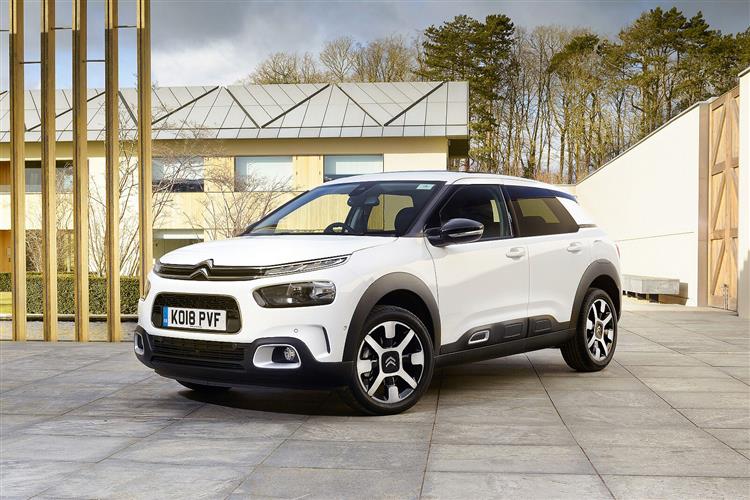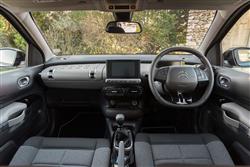How will you view?
This is a sample, showing 30 seconds of each section.
QUIRKY BUT SENSIBLE (some text hidden) SECTIONED_new_citroenc4cactus_2018
By Jonathan Crouch
Introductionword count: 100
Citroen's C4 Cactus hatch got a reboot in its much facelifted post-2018 improved form. It became a little less extrovert in this guise, but was still fashion-led and highly personalisable. These are attributes which ought to have played well for buyers seeking something a little different in the more conventional family hatch sector where Citroen repositioned this product. Sales though, were slow. The key changes here came as part of the company's 'Advanced Comfort' programme, which brought more supportive seats and a clever new suspension system. So, charisma and comfort take centre stage in a very individual little family car.
Modelsword count: 14
5dr Family Hatch (Petrol - 1.2 [110hp, 130hp] / Diesel - 1.6 BlueHDi [100hp,120hp])
Historyword count: 437
In a market full of family hatchbacks determined to become SUVs, it's rather refreshing to find a product with the opposite perspective. Citroen's C4 Cactus started out in 2014 as the brand's offering to buyers in search of a compact crossover. In 2018 though, it re-invented itself as a more conventional family hatchback, but one with a rather unique perspective on life. If you're at all familiar with the way the Citroen model line-up has developed in recent times, the reason for this change of product emphasis becomes fairly clear. By the time of this evolved C4 Cactus model's introduction in early 2018, the brand had launched two compact SUVs, the C3 Aircross and the C5 Aircross, so no longer really needed this Cactus to appeal to the crossover crowd. What it did need was something that would represent the company in the mainstream Focus, Astra and Golf-dominated family hatch 'C'-sector. This territory ought to have been covered by Citroen's conventional C4 hatch model, but the rather dull second generation version of that car was phased out in late 2017 due to slow sales. To bridge the gap to the introduction of the next generation C4 hatch in late 2020, the brand decided to rely on this rejuvenated C4 Cactus to take on heavyweight volume rivals in this crucially important market segment. To be able to do that, the cheerful, quirky demeanour that marked out the original Cactus model needed to mature a little. The huge side-mounted 'Airbump' panels that characterised that earlier design represented a fun touch for crossover buyers but risked looking merely silly on a product repositioned to appeal to more conventional folk. To please these people, this Citroen needed to offer a core attribute with a little more substance - and did. 'Comfort', the advertising around this car proclaimed, 'is the new cool'. Perhaps. It's certainly a virtue that used to characterise this Gallic brand in the days of legendary models like the Traction Avant, the 2CV and the DS. In more recent times when Citroens became little more than re-badged Peugeots, that selling point was sacrificed, but the company decided to resurrect it in 2018 with its so-called 'Advanced Comfort' programme. In the C4 Cactus, this delivered super-supportive 'Advanced Comfort' seats and a clever new suspension system using what the marque called 'Progressive Hydraulic Cushions'. There was also a smarter, more spacious-feeling cabin, extensive personalisation opportunities, much improved safety provision and the option of an extra more powerful PureTech 130 petrol engine at the top of the range. Sales though were slow and this car was deleted from the range in 2020.
What You Getword count: 572
Rarely has a car been so characterised by a single styling feature as was the original version of this model. At its launch in 2014, the so-called 'Airbump' panels, slavered over its sides like slabs of Dairy Milk chocolate, were all people wanted to talk about. The Airbumps didn't disappear entirely with this post-2018-era revised model, but they shrunk in size to a point where people no longer noticed them quite so much. There were more signs of maturity at the front, which in this facelifted guise gained the look of a proper car rather than an overgrown Tonka toy. As before, there was a two-tier lighting signature, but with this updated model, the upper daytime running light strip flows into the kind of broad Citroen signature grille that features on other models in the company's range. Inside, the changes made to create this improved model were less obvious - until you start to inspect the generously proportioned 'Advanced Comfort' seats, which are completely different to those installed on the original model. They feature broader bases and foam that's 15mm thicker for extra support, plus the extra quilted padding creates an inviting visual signature that doesn't disappoint once you squish yourself into place. Otherwise, the minimalistic cabin with its designer flourishes remained much as before. So you get door handles inspired by leather luggage straps and what is probably our favourite feature, a huge, stylised lidded glovebox - Citroen likes to call it a 'Top Box'. The reason it's so big is that the dashboard doesn't have to swallow a passenger airbag, this feature instead moved up to the roof where it's mounted just under the headlining. Otherwise, the atmosphere is simple and so free from button clutter that it borders on feeling rather sparse. That's because the operational functionality of the car is confined almost completely to a couple of digital LCD screens, the smaller of the two visible through a rather ugly but very Citroen-esque three-spoke steering wheel. Switch your gaze to the middle of the fascia and you'll find buttons and switchgear notable by their absence, almost everything instead having been moved onto a 7-inch colour touchscreen. What about when you use the wide-opening doors, take a seat in the rear and put the practical promises Citroen has made with this car to the test, principally those suggesting family hatch standards of space despite the supermini underpinnings? Well, in terms of legroom, this model delivers on those claims thanks to a platform that was stretched so as to provide a class-competitive wheelbase length. The designers also did their best to make this revised model feel a little more spacious than its predecessor, re-sculpting the door panels to increase elbow room and hollowing out the front seat backs to increase knee space. But there is a problem: Citroen didn't sort out proper wind-up windows for the rear doors, which means that this Cactus continued to be stuck with fiddly pop-out side glass panels. And the boot? Well the plastic tailgate's super-light and when you raise it, you'll find the same 358-litre capacity that was on offer before. We were pleased to find two key practical changes here that were made with the revised version of this car. A proper 60:40 split makes an appearance for the rear seat back and equally welcome was the brand's decision to include a space-saver spare wheel beneath the cargo area base across the range.
To see the full road test text contact us on 0330 0020 227
Pictures (high res disabled)

.jpg)
|
.jpg)
|
.jpg)
| |||
.jpg)
|
.jpg)
|
.jpg)
| |||
.jpg)
|
.jpg)
|
.jpg)
| |||
.jpg)
|

|
Scoring (subset of scores)
Category: Compact Family Cars
| Performance | |
| Handling | |
| Comfort | |
| Space | |
| Styling, Build, Value, Equipment, Depreciation, Handling, Insurance and Total scores are available with our full data feed. | |



